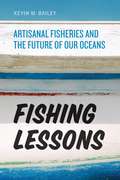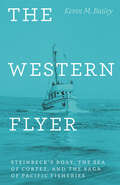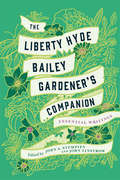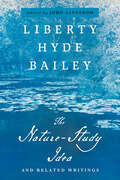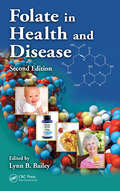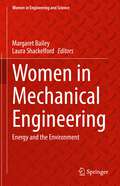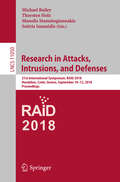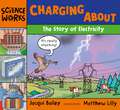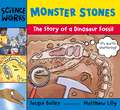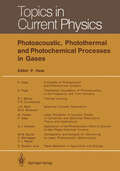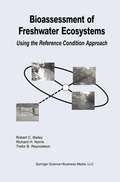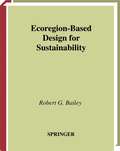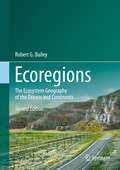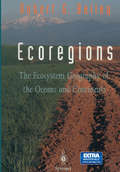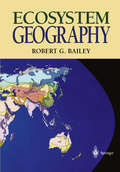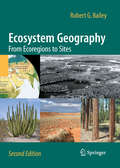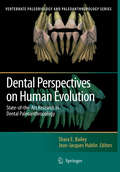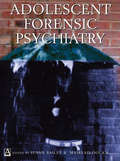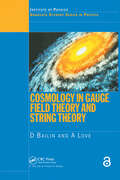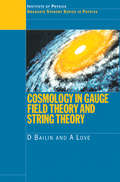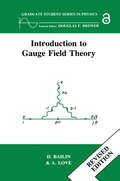- Table View
- List View
Fishing Lessons: Artisanal Fisheries and the Future of Our Oceans
by Kevin M. BaileyFish bones in the caves of East Timor reveal that humans have systematically fished the seas for at least 42,000 years. But in recent centuries, our ancient, vital relationship with the oceans has changed faster than the tides. As boats and fishing technology have evolved, traditional fishermen have been challenged both at sea and in the marketplace by large-scale fishing companies whose lower overhead and greater efficiency guarantee lower prices. In Fishing Lessons, Kevin M. Bailey captains a voyage through the deep history and present course of this sea change—a change that has seen species depleted, ecosystems devastated, and artisanal fisheries transformed into a global industry afloat with hundreds of billions of dollars per year. Bailey knows these waters, the artisanal fisheries, and their relationship with larger ocean ecology intimately. In a series of place-based portraits, he shares stories of decline and success as told by those at the ends of the long lines and hand lines, channeling us through the changing dynamics of small-scale fisheries and the sustainability issues they face—both fiscal and ecological. We encounter Paolo Vespoli and his tiny boat, the Giovanni Padre,in the Gulf of Naples; Wenche, a sea Sámi, one of the indigenous fisherwomen of Norway; and many more. From salmon to abalone, the Bay of Fundy to Monterey and the Amazon, Bailey’s catch is no fish tale. It is a global story, casting a net across waters as vast and distinct as Puget Sound and the Chilean coast. Sailing across the world, Bailey explores the fast-shifting current of how we gather food from the sea, what we gain and what we lose with these shifts, and potential solutions for the murky passage ahead.
The Western Flyer: Steinbeck's Boat, the Sea of Cortez, and the Saga of Pacific Fisheries
by Kevin M. BaileyIn January 2010, the Gemini was moored in the Swinomish Slough on a Native American reservation near Anacortes, Washington. Unbeknownst to almost everyone, the rusted and dilapidated boat was in fact the most famous fishing vessel ever to have sailed: the original Western Flyer, immortalized in John Steinbeck’s nonfiction classic The Log from the Sea of Cortez. In this book, Kevin M. Bailey resurrects this forgotten witness to the changing tides of Pacific fisheries. He draws on the Steinbeck archives, interviews with family members of crew, and more than three decades of working in Pacific Northwest fisheries to trace the depletion of marine life through the voyages of a single ship. After Steinbeck and his friend Ed Ricketts—a pioneer in the study of the West Coast’s diverse sea life and the inspiration behind “Doc” in Cannery Row—chartered the boat for their now-famous 1940 expedition, the Western Flyer returned to its life as a sardine seiner in California. But when the sardine fishery in Monterey collapsed, the boat moved on: fishing for Pacific ocean perch off Washington, king crab in the Bering Sea off Alaska, and finally wild Pacific salmon—all industries that would also face collapse. As the Western Flyer herself faces an uncertain future—a businessman has bought her, intending to bring the boat to Salinas, California, and turn it into a restaurant feature just blocks from Steinbeck’s grave—debates about the status of the California sardine, and of West Coast fisheries generally, have resurfaced. A compelling and timely tale of a boat and the people it carried, of fisheries exploited, and of fortunes won and lost, The Western Flyer is environmental history at its best: a journey through time and across the sea, charting the ebb and flow of the cobalt waters of the Pacific coast.
The Western Flyer: Steinbeck's Boat, the Sea of Cortez, and the Saga of Pacific Fisheries
by Kevin M. BaileyIn January 2010, the Gemini was moored in the Swinomish Slough on a Native American reservation near Anacortes, Washington. Unbeknownst to almost everyone, the rusted and dilapidated boat was in fact the most famous fishing vessel ever to have sailed: the original Western Flyer, immortalized in John Steinbeck’s nonfiction classic The Log from the Sea of Cortez. In this book, Kevin M. Bailey resurrects this forgotten witness to the changing tides of Pacific fisheries. He draws on the Steinbeck archives, interviews with family members of crew, and more than three decades of working in Pacific Northwest fisheries to trace the depletion of marine life through the voyages of a single ship. After Steinbeck and his friend Ed Ricketts—a pioneer in the study of the West Coast’s diverse sea life and the inspiration behind “Doc” in Cannery Row—chartered the boat for their now-famous 1940 expedition, the Western Flyer returned to its life as a sardine seiner in California. But when the sardine fishery in Monterey collapsed, the boat moved on: fishing for Pacific ocean perch off Washington, king crab in the Bering Sea off Alaska, and finally wild Pacific salmon—all industries that would also face collapse. As the Western Flyer herself faces an uncertain future—a businessman has bought her, intending to bring the boat to Salinas, California, and turn it into a restaurant feature just blocks from Steinbeck’s grave—debates about the status of the California sardine, and of West Coast fisheries generally, have resurfaced. A compelling and timely tale of a boat and the people it carried, of fisheries exploited, and of fortunes won and lost, The Western Flyer is environmental history at its best: a journey through time and across the sea, charting the ebb and flow of the cobalt waters of the Pacific coast.
The Western Flyer: Steinbeck's Boat, the Sea of Cortez, and the Saga of Pacific Fisheries
by Kevin M. BaileyIn January 2010, the Gemini was moored in the Swinomish Slough on a Native American reservation near Anacortes, Washington. Unbeknownst to almost everyone, the rusted and dilapidated boat was in fact the most famous fishing vessel ever to have sailed: the original Western Flyer, immortalized in John Steinbeck’s nonfiction classic The Log from the Sea of Cortez. In this book, Kevin M. Bailey resurrects this forgotten witness to the changing tides of Pacific fisheries. He draws on the Steinbeck archives, interviews with family members of crew, and more than three decades of working in Pacific Northwest fisheries to trace the depletion of marine life through the voyages of a single ship. After Steinbeck and his friend Ed Ricketts—a pioneer in the study of the West Coast’s diverse sea life and the inspiration behind “Doc” in Cannery Row—chartered the boat for their now-famous 1940 expedition, the Western Flyer returned to its life as a sardine seiner in California. But when the sardine fishery in Monterey collapsed, the boat moved on: fishing for Pacific ocean perch off Washington, king crab in the Bering Sea off Alaska, and finally wild Pacific salmon—all industries that would also face collapse. As the Western Flyer herself faces an uncertain future—a businessman has bought her, intending to bring the boat to Salinas, California, and turn it into a restaurant feature just blocks from Steinbeck’s grave—debates about the status of the California sardine, and of West Coast fisheries generally, have resurfaced. A compelling and timely tale of a boat and the people it carried, of fisheries exploited, and of fortunes won and lost, The Western Flyer is environmental history at its best: a journey through time and across the sea, charting the ebb and flow of the cobalt waters of the Pacific coast.
The Western Flyer: Steinbeck's Boat, the Sea of Cortez, and the Saga of Pacific Fisheries
by Kevin M. BaileyIn January 2010, the Gemini was moored in the Swinomish Slough on a Native American reservation near Anacortes, Washington. Unbeknownst to almost everyone, the rusted and dilapidated boat was in fact the most famous fishing vessel ever to have sailed: the original Western Flyer, immortalized in John Steinbeck’s nonfiction classic The Log from the Sea of Cortez. In this book, Kevin M. Bailey resurrects this forgotten witness to the changing tides of Pacific fisheries. He draws on the Steinbeck archives, interviews with family members of crew, and more than three decades of working in Pacific Northwest fisheries to trace the depletion of marine life through the voyages of a single ship. After Steinbeck and his friend Ed Ricketts—a pioneer in the study of the West Coast’s diverse sea life and the inspiration behind “Doc” in Cannery Row—chartered the boat for their now-famous 1940 expedition, the Western Flyer returned to its life as a sardine seiner in California. But when the sardine fishery in Monterey collapsed, the boat moved on: fishing for Pacific ocean perch off Washington, king crab in the Bering Sea off Alaska, and finally wild Pacific salmon—all industries that would also face collapse. As the Western Flyer herself faces an uncertain future—a businessman has bought her, intending to bring the boat to Salinas, California, and turn it into a restaurant feature just blocks from Steinbeck’s grave—debates about the status of the California sardine, and of West Coast fisheries generally, have resurfaced. A compelling and timely tale of a boat and the people it carried, of fisheries exploited, and of fortunes won and lost, The Western Flyer is environmental history at its best: a journey through time and across the sea, charting the ebb and flow of the cobalt waters of the Pacific coast.
The Liberty Hyde Bailey Gardener's Companion: Essential Writings
by Liberty Hyde Bailey"Every family can have a garden." -Liberty Hyde BaileyFinally, the best and most accessible garden writings of perhaps the most influential literary gardener of the twentieth century have been brought together in one book. Philosopher, poet, naturist, educator, agrarian, scientist, and garden-lover par excellence Liberty Hyde Bailey built a reputation as the Father of Modern Horticulture and evangelist for what he called the "garden-sentiment"—the desire to raise plants from the good earth for the sheer joy of it and for the love of the plants themselves. Bailey's perennial call to all of us to get outside and get our hands dirty, old or young, green thumb or no, is just as fresh and stirring today as then.Full of timeless wit and grace, The Liberty Hyde Bailey Gardener's Companion collects essays and poems from Bailey's many books on gardening, as well as from newspapers and magazines from the era. Whether you've been gardening for decades or are searching for your first inspiration, Bailey's words will make an ideal companion on your journey.
The Nature-Study Idea: And Related Writings (The Liberty Hyde Bailey Library)
by Liberty Hyde BaileyIn The Nature-Study Idea, Liberty Hyde Bailey articulated the essence of a social movement, led by ordinary public-school teachers, that lifted education out of the classroom and placed it into firsthand contact with the natural world. The aim was simple but revolutionary: sympathy with nature to increase the joy of living and foster stewardship of the earth.With this definitive edition, John Linstrom reintroduces The Nature-Study Idea as an environmental classic for our time. It provides historical context through a wealth of related writings, and introductory essays relate Bailey's vision to current work in education and the intersection of climate change and culture. In this period of planetary turmoil, Bailey's ambition to cultivate wonder (in adults as well as children) and lead readers back into the natural world is more important than ever.
Folate in Health and Disease
by Lynn B. BaileyDuring the fifteen years since the bestselling first edition of Folate in Health and Disease was published, there have been thousands of new research studies related to folate and its role in health and disease. The second edition of the book uniquely bridges the gap between basic science and public health/clinical medicine.Presents Groundbreaking
Women in Mechanical Engineering: Energy and the Environment (Women in Engineering and Science)
by Margaret Bailey Laura ShackelfordThis book features influential scholarly research and technical contributions, professional trajectories, disciplinary shifts, personal insights, and a combination of these from a group of remarkable women within mechanical engineering. Combined, these chapters tell an important story about the dynamic field of mechanical engineering in the areas of energy and the environment, as seen from the perspective of some of its most extraordinary women scientists and engineers. The volume shares with the Women in Engineering and Science Series the primary aim of documenting and raising awareness of the valuable, multi-faceted contributions of women engineers and scientists, past and present, to these areas. Women in mechanical engineering and energy and the environment are historically relevant and continue to lead these fields as passionate risk takers, entrepreneurs, innovators, educators, and researchers. Chapter authors are members of the National Academies, winners of major awards and recognition that include Presidential Medals, as well as SWE, SAE, ASME, ASEE and IEEE Award winners and Fellows.
Research in Attacks, Intrusions, and Defenses: 21st International Symposium, RAID 2018, Heraklion, Crete, Greece, September 10-12, 2018, Proceedings (Lecture Notes in Computer Science #11050)
by Michael Bailey Thorsten Holz Manolis Stamatogiannakis Sotiris IoannidisThis book constitutes the refereed proceedings of the 21st International Symposium on Research in Attacks, Intrusions, and Defenses, RAID 2018, held in Heraklion, Crete, Greece, in September 2018.The 32 revised full papers were carefully reviewed and selected from 145 submissions. They are organized in the following topical sections: attacks; intrusion detection and prevention; DDoS attacks; passwords, accounts, and users; machine learning for computer security; hardware-assisted security; software security; malware; IoT/CPS security; security measurements; and defenses.
Charging About: The Story of Electricity (Science Works)
by Ms Jacqui BaileyA brand new edition of Charging About from the Science Works series, featuring lively storytelling and fun, engaging illustrations to aid children in their learning.Press a button, flick a switch, turn a knob and zap . . . something amazing happens. You have music, light, heat, hairdryers - all because of electricity.In this revised edition from Jacqui Bailey, we follow the story of how electrical energy is generated in a power station, how it travels through pylons, power cables and wires until it reaches towns and homes. We learn how electrical current is created and how it is made safe. This book also contains an experiment, more great facts to know, useful websites and an index.Book band: LimeIdeal for KS2.
Charging About: The Story of Electricity (Science Works)
by Ms Jacqui BaileyA brand new edition of Charging About from the Science Works series, featuring lively storytelling and fun, engaging illustrations to aid children in their learning.Press a button, flick a switch, turn a knob and zap . . . something amazing happens. You have music, light, heat, hairdryers - all because of electricity.In this revised edition from Jacqui Bailey, we follow the story of how electrical energy is generated in a power station, how it travels through pylons, power cables and wires until it reaches towns and homes. We learn how electrical current is created and how it is made safe. This book also contains an experiment, more great facts to know, useful websites and an index.Book band: LimeIdeal for KS2.
Monster Stones: The Story of a Dinosaur Fossil (Science Works)
by Ms Jacqui BaileyA brand new edition of Monster Stones from the Science Works series, featuring lively storytelling and fun, engaging illustrations to aid children in their learning.Millions of years ago, a hungry dinosaur did something daft and died in a river. What happened next is one of the oldest stories in the world – the dinosaur became a FOSSIL.This book takes the reader back millions of years to tell the story of a dinosaur's death. Through this story, we discover how fossils are formed. We also learn how they are discovered, removed, researched and preserved in museums. This book also contains an experiment, more great facts to know, useful websites and an index.Book band: LimeIdeal for KS2.
Photoacoustic, Photothermal and Photochemical Processes in Gases (Topics in Current Physics #46)
by R. T. Bailey S. Bernegger D. Bicanic F. Bijnen C.W.P.M. Blom F. R. Cruickshank G. J. Diebold M. Fiedler F. Harren P. Hess H. Jalink M. Kooijman J. B. Mehl P. L. Meyer M. R. Moldover D. Pugh J. Reuss H. Sauren M. W. Sigrist J. Snel W. Tonk L. Van Hove L.A.C.J. Voesenek E. Woltering B. ZuidbergGas-phase photoacoustics are treated comprehensively for the first time in this book. Review articles by leading scientists in the respective research areas introduce their fields, review present knowledge and conclude with the latest developments and future prospects. Topics covered include the theory of photoacoustics in the frequency and time domains, acoustic resonator models, a great variety of experimental setups and techniques, studies of spectrocopy and fundamental kinetic processes such as energy transfer and chemical reactions, and applications such as air and exhaust monitoring and trace gas detection in biology and agriculture. The book will interest newcomers to photoacoustics, since it gives an overview of the important directions of current research and detailed descriptions of experimental methods. It will also be a valuable source of information for those already involved in photoacoustic research due to its clear presentation of theory and experimental results. All relevant literature references in this rapidly expanding field of laser applications are included.
Bioassessment of Freshwater Ecosystems: Using the Reference Condition Approach
by Robert C. Bailey Richard H. Norris Trefor B. ReynoldsonAquatic ecosystem assessment is a rapidly developing field, and one of the newer approaches to assessing the condition of rivers and lakes is the Reference Condition Approach. This is a significant advancement in biomonitoring because it solves the problem of trying to locate nearby control or reference sites when studying an ecosystem that may be degraded, a problem that bedevils traditional approaches. Rather than using upstream reference sites in a river system or next-bay-over reference sites in a lake, an array of ecologically similar, least-exposed to stress sites scattered throughout a catchment or region is used. Once the reference condition has been established, any site suspected of being impacted can be assessed by comparison to the reference sites, and its status determined. The Reference Condition database, once formed, can be used repeatedly.
Ecoregion-Based Design for Sustainability
by Robert G. BaileyRobert Bailey is an established authority on ecosystems, and his previous works, Ecosystem Geography and Ecoregions have sold well; Fully illustrated with color diagrams and maps; Includes a Glossary to define terms which may be unfamiliar to professionals working in this cross-disciplinary field; Provides a Resource Guide and a Sources and Recommended Reading section to aid readers who require additional information; Presents a modified approach to land management and conservation in a non-technical and engaging manner
Ecoregions: The Ecosystem Geography of the Oceans and Continents
by Robert G. BaileyGlobal warming and human-driven impacts are changing the World’s ecological zones. This book applies the principles described in Bailey’s Ecosystem Geography: From Ecoregions to Sites, 2nd ed. (Springer 2009, 1st ed. 1996) to describe and characterize the major terrestrial and aquatic ecological zones of the Earth. Bailey’s system for classifying these zones has been adopted by major organizations such as the U.S. Forest Service and The Nature Conservancy and this book is a significant contribution to a long tradition of classifying and studying the world’s ecological regions or ecoregions. It includes two color maps that show the major ecoregions of the continents and oceans. Also included are: - 106 illustrations with 55 in full color - A new chapter on mountains is included. - There are new sections that address concerns about how eco regions are changing under the relentless influence of humans and climate change - Another new feature is the discussion of using eco regional patterns to transfer research results and select sites for detecting climate change effects on ecosystem distribution - Use of ecoregional patterns to design monitoring networks and sustainable landscapes - Fire regimes in different regional ecosystems and their management implications.
Ecoregions: The Ecosystem Geography of the Oceans and Continents
by Robert G. BaileyEcoregions applies the principles described in Bailey's Ecosystem Geography to describe and characterize the major terrestrial and aquatic ecological zones of the Earth. Robert Bailey's system for classifying ecoregions has had a major influence, and has been adopted by major organizations such as the US Forest Service and The Nature Conservancy. This book includes numerous photographs of representative ecoregions, and outstanding color figures are complemented by two full-color maps showing the major ecoregions of the continents and of the oceans.
Ecosystem Geography
by Robert G. BaileyThe analysis and management of ecosystems rely increasingly on sound geographical knowledge. Ecosystem Geography is a landmark contribution which brings the geographer's tools - maps, scales, boundaries, and units - to the study of ecosystems. The author, a senior geographer and program manager with the U.S. Forest Service, has distilled more than two decades of research on ecosystem mapping and classification. His work has had a growing influence on how government and academic scientists are using ecological data to monitor biodiversity, manage land holdings, and interpret the results of climatic change. Ecosystem Geography features spectacular graphics, including diagrams, photographs, and abundant maps. It will be welcomed by ecologists, geographers, land and resource specialists, and anyone involved in the study of ecosystems.
Ecosystem Geography: From Ecoregions to Sites
by Robert G. BaileyThis book outlines a system that subdivides the Earth into a hierarchy of increasingly finer-scale ecosystems that can serve as a consistent framework for ecological analysis and management. The system consists of a three-part, nested hierarchy of ecosystem units and associated mapping criteria. This new edition has been updated throughout with new text, figures, diagrams, photographs, and tables.
Dental Perspectives on Human Evolution: State of the Art Research in Dental Paleoanthropology (Vertebrate Paleobiology and Paleoanthropology)
by Shara E. Bailey Jean-Jacques HublinThe objective of the volume is to bring together, in one collection, the most innovative dental anthropological research as it pertains to the study of hominid evolution. In the past few decades both the numbers of hominid dental fossils and the sophistication of the techniques used to analyze them have increased substantially. The book’s contributions focus on dental morphometrics, growth and development, diet and dental evolution.
Adolescent Forensic Psychiatry
by Susan Bailey Mairead DolanAdolescent Forensic Psychiatry discusses a broad range of issues based around the psychiatric needs of adolescents and how these relate to offending behaviour. Its well-structured approach looks at assessment, treatment and outcomes for different disorders and highlights the importance of effective interaction between specialist agencies. Services
Cosmology in Gauge Field Theory and String Theory
by D. Bailin A. LoveCosmology in Gauge Field Theory and String Theory focuses on the cosmological implications of the gauge theories of particle physics and of string theory. The book first examines the universe's series of phase transitions in which the successive gauge symmetries of the higher-temperature phase were spontaneously broken after the big bang, discussing relics of these phase transitions, more generic relics (baryons, neutrinos, axions), and supersymmetric particles (neutralinos and gravitinos). The author next studies supersymmetric theory, supergravity theory, and the constraints on the underlying field theory of the universe's inflationary era. The book concludes with a discussion of black hole solutions of the supergravity theory that approximates string theory at low energies and the insight that string theory affords into the microscopic origin of the Bekenstein-Hawking entropy.Cosmology in Gauge Field Theory and String Theory provides a modern introduction to these important problems from a particle physicist's perspective. It is intended as an introductory textbook for a first course on the subject at a graduate level.
Cosmology in Gauge Field Theory and String Theory
by D. Bailin A. LoveCosmology in Gauge Field Theory and String Theory focuses on the cosmological implications of the gauge theories of particle physics and of string theory. The book first examines the universe's series of phase transitions in which the successive gauge symmetries of the higher-temperature phase were spontaneously broken after the big bang, discussing relics of these phase transitions, more generic relics (baryons, neutrinos, axions), and supersymmetric particles (neutralinos and gravitinos). The author next studies supersymmetric theory, supergravity theory, and the constraints on the underlying field theory of the universe's inflationary era. The book concludes with a discussion of black hole solutions of the supergravity theory that approximates string theory at low energies and the insight that string theory affords into the microscopic origin of the Bekenstein-Hawking entropy.Cosmology in Gauge Field Theory and String Theory provides a modern introduction to these important problems from a particle physicist's perspective. It is intended as an introductory textbook for a first course on the subject at a graduate level.
Introduction to Gauge Field Theory Revised Edition
by David Bailin Alexander LoveIntroduction to Gauge Field Theory provides comprehensive coverage of modern relativistic quantum field theory, emphasizing the details of actual calculations rather than the phenomenology of the applications. Forming a foundation in the subject, the book assumes knowledge of relativistic quantum mechanics, but not of quantum field theory. The book
